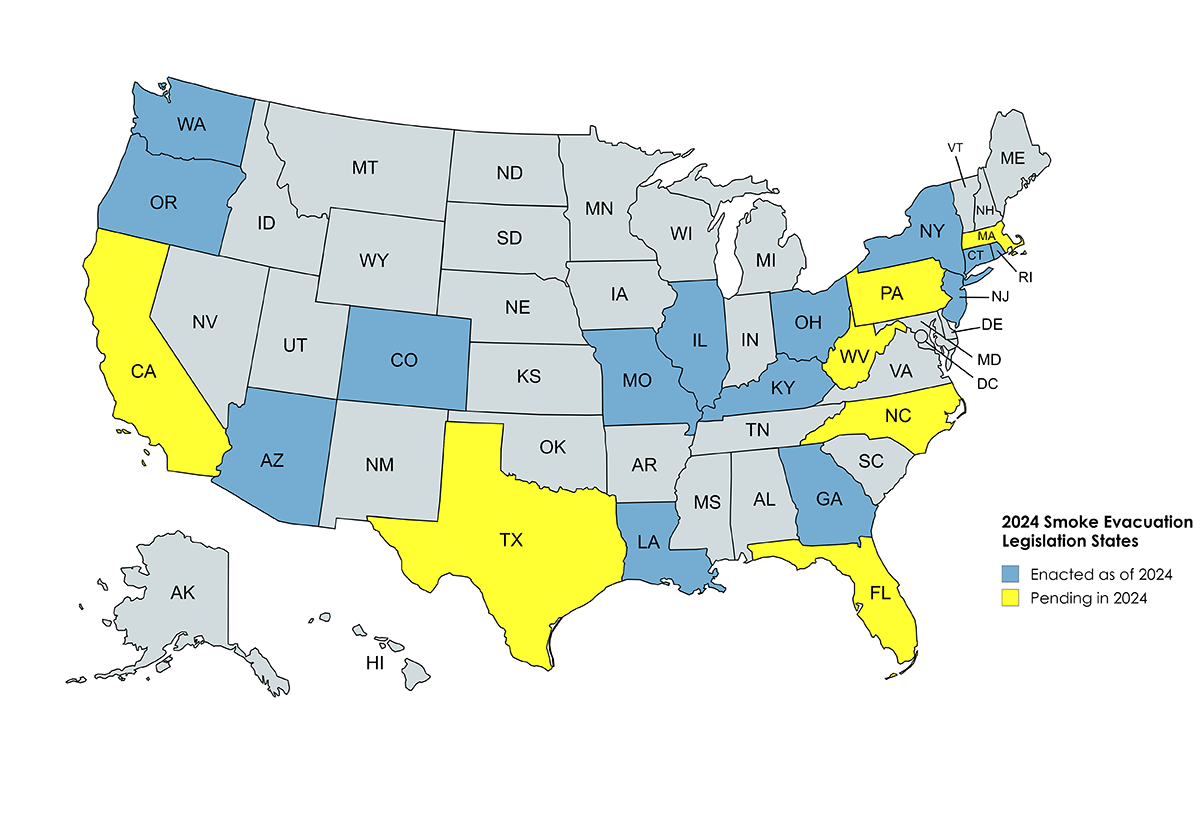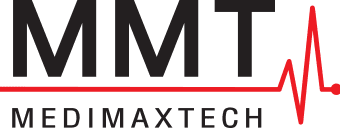Smoke Evacuation Legislation States

Download our Dangers of OR Smoke Information PDF
Did you know that surgical smoke vapors contain neurotoxic compounds such as xylene, and toluene, in traceable amounts? They are the same chemicals used in industrial cleaners, and dry-cleaning solution. A danger for anyone exposed by simply breathing fumes.
Chemical Composition of Smoke Produced by High-Frequency Electrosurgery
O.S. Al Sahaf; I.Vega-Carrascal; F.O. Cunningham; J.P. MCGrath; F.J. Bloomfield; Irish Journal of Medical Science; 7/2007
Categories: Aesthetics, Cardiothoracic, Dermatology, Drills, ENT, General, Laparoscopic, Laser, Orthopedic, Plastic, Plume, Saws, Smoke
This study demonstrated the presence of irritant, carcinogenic and neurotoxic compounds in electrosurgical smoke such as toluene, ethylbenzene and xylene. This may have considerable implications for the health and safety of all involved in surgical…
Electrocautery smoke has shown to have almost the identical chemical makeup to cigarette smoke. Studies show that one gram of ablated tissue is the equivalent to smoking six cigarettes.
Cancer risk of incremental exposure to polycyclic aromatic hydrocarbons in electrocautery smoke for mastectomy personnel.
World Journal of Surgical Oncology 2014 12:31
https://doi.org/10.1186/1477-7819-12-31
© Tseng et al.; licensee BioMed Central Ltd. 2014
Submicron particles in ES in the ORs during modern surgery are an inevitable nuisance and contain carcinogenic chemicals. In measuring particle number concentrations at various size ranges in mastectomy, more than 70% of ES particles were found to be smaller than 0.3 μm, indicating that the particles may threaten the health of surgical personnel through respiration…
Surgical Smoke has shown to be a long-term exposure issue for surgery personnel. Smoke vapors affect most operating room staff daily from pro-longed exposure with symptoms like (headaches, sore throat, fatigue). Surgical staff leave their place of employment with the smell of burnt human tissue, & particulate in their nose, on their skin, and in their hair.
Health risks associated with exposure to surgical smoke for surgeons and operation room personnel.
Abstract
Okoshi K1, Kobayashi K, Kinoshita K, Tomizawa Y, Hasegawa S, Sakai Y.
Department of Surgery, Japan Baptist Hospital, 47 Yamonomoto-cho, Kitashirakawa, Sakyo-ku, Kyoto, 606-8273, Japan,
kae_md@kuhp.kyoto-u.ac.jp.
Surg Today. 2015 Aug;45(8):957-65. doi: 10.1007/s00595-014-1085-z. Epub 2014 Nov 25.
Although surgical smoke contains potentially hazardous substances, such as cellular material, blood fragments, microorganisms, toxic gases and vapors, many operating rooms (ORs) do not provide protection from exposure to it…
Surgical smoke is more than a “barbeque” of human tissue! The thermal destruction of human tissue creates a dangerous plume by-product that includes live viruses, blood fragments, carcinogens, mutagens, hydrogen cyanide, Cellular Matter and more… When smoke vapors are not properly removed from the surgical suite, this also become a safety issue for the patient as well as the staff.
The Dangers of Electrosurgical Smoke to Operating Room Personnel: A Review
Kevin Bree, MD , Spencer Barnhill, BS , & William Rundell, MD, FACS
Workplace Health & Safety vol. 65 no. 11 Sage Journal Publication Copyright© 2017
Although evidence is currently inadequate to directly link electrosurgical smoke to increased morbidity and mortality among OR personnel, the authors of this review recommend the regular use of smoke evacuation in ORs…
Standards are already in place by the US federal government, along with regulations by health care accreditation organizations such as The Joint Commission (JACHO) and others…
Rhode Island, & Colorado were the first two states to adopt regulations on the use of surgical smoke evacuation for ANY PROCEDURE producing surgical plume. More will follow this trend with individual state legislation, until a federal law is passed.
The Joint Commission Environment of Care Standard may be located in its entirety at the following:
The Joint Commission Hospital Accreditation Standards- See EC .02.02.01
(See page 5 of 20 for the excerpt related to surgical plume. Line 9 states
“organization manages risks related to hazardous materials and waste”; specifically “vapors generated during use of electro
cauterization equipment” as a standard in which a “Measure of Success is needed”.)
**The Joint Commission Resources 2009 CSR ACD Continuous Performance Review & Self- Assessment–Hospital
Accreditation (SEE Page 2, Standard EC.02.02.01, Lines 9 & 10.)
The OSHA Surgical Suite Module pertaining to surgical plume has also been updated HERE . (“Evacuate all smoke, no matter how much is generated… Consider all tubing, filters, and absorbers as infectious waste and dispose of them appropriately. Use Universal Precautions as required by the OSHA Bloodborne Pathogens Standard when contaminated with blood or OPIM [29 CFR 1910.1030(d)(1)].”)
The OSHA General Duty Clause may be found HERE (Sec. 5 A1) Each Employer shall furnish each of his or her employees employment and a place of employment which are free from recognized hazards that are causing, or are likely to cause serious physical harm, or death to the employee.
The OSHA Respiratory Standard may be located HERE.
(See 1910.134(a)(1) “In the control of those occupational diseases caused by breathing air contaminated with harmful dusts, fogs, fumes, mists, gases, smokes, sprays, or vapors, the primary objective shall be to prevent atmospheric contamination. This shall be accomplished as far as feasible by accepted engineering control measures (for example, enclosure or confinement of the operation, general and local ventilation, and substitution of less toxic materials”).
The CDC/ NIOSH HC11 Hazard Controls for surgical smoke:
Recommended ventilation techniques include a combination of general room (Wall suction) & local exhaust ventilation (LEV: Portable smoke evacuation systems) to properly remove surgical smoke vapors from an operating room Theater. https://www.cdc.gov/niosh/docs/hazardcontrol/hc11.html

